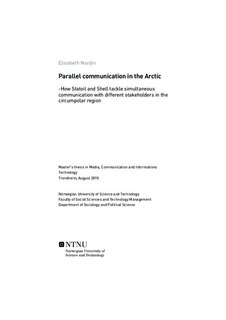| dc.description.abstract | Today, a war of words is all it takes to make or break a business. Oil companies are no
exception, and are feeling the pressure when non-governmental organizations are turning the tide of public opinion against them. As lucrative and big companies, one would think they have the capability and the communications know-how to have an advantage over
organizations mostly made up of volunteers, but communication is intricate and complex.
Crane and Livesey (2003) argue that understanding what dialogue is and what purposes and results it actually has is poorly understood, thus I have organized a case study of how Statoil and Shell tackle dialogues with several stakeholders at the same time in the Arctic region, a phenomenon which I am calling “parallel communication.” In this study I will be looking at some theories and stakeholder communications models and see whether or not these Insights are relevant to my case study through key informant interviews with six Communications experts from Statoil and Shell working in the circumpolar region, and content analysis of Statoil presentations to stakeholders and Shell’s strategies for stakeholder engagement. The aim of this paper was to examine the trends from the experiences of my informants, and the manner in which they present themselves with their texts, and create a new model for parallel communication that may shed light on how dialogue is conducted in this case study, and hopefully contribute to communications and stakeholder engagement literature with what is hopefully a practical and effective model for communications processes. Central findings are that customization, although not blatant, is a prevalent strategy used by the companies. A source of repeated frustration for my informants was a lack of internal symbiosis which can sometimes affect stakeholder engagements negatively. My informants are also locked in a battle of narratives with the environmental movement, a battle which they are having
difficulties with. My study finds that my informants tend to want to identify “special publics”
with which to engage in dialogue with, although seeing their difficulties with public opinion,
perhaps it would be fruitful to widen the scope of stakeholders and include the general public. | nb_NO |
